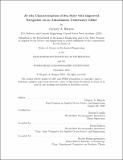In-situ Characterization of Sea State with Improved Navigation on an Autonomous Underwater Glider
Author(s)
Burgess, Gregory A.
DownloadThesis PDF (46.39Mb)
Advisor
Camilli, Richard
Terms of use
Metadata
Show full item recordAbstract
This thesis presents an Autonomous Underwater Glider (AUG) architecture with improved onboard navigation and acoustics-based sensing intended to enable basin-scale unattended surveys of our Earth's most remote oceans. Traditional AUGs have long-been an important platform for oceanographic surveys due to their high endurance and autonomy, yet lack the operational flexibility to operate in many regions of scientific interest and the sensing capability to capture scientific data at the air-sea interface. Particularly of interest is the marginal ice zone (MIZ) in the Arctic and the Southern Ocean, as both are vitally important to understanding global climate trends, yet prohibitively expensive to persistently monitor with support vessels. To fill this observational gap, the sensing, navigation, and adaptability of AUGs must be improved. This is possible by employing onboard acoustic sensing for sea state observation and navigation, as well as incorporating vehicle improvements targeting maneuverability and intelligent adaptability to evolving environmental states.
To enable persistent monitoring of both the water-column and air-sea interface, this thesis proposes an improved vehicle architecture for a more capable AUG, a real-time DVL-aided navigation process that leverages ocean current sensing to limit localization error, and a subsea acoustics-based sea state characterization method capable of analyzing wave spectra under-ice and with zero surface expression. These methods are evaluated with respect to extensive laboratory experiments and field data collected during in-situ implementation.
Date issued
2022-09Department
Massachusetts Institute of Technology. Department of Mechanical EngineeringPublisher
Massachusetts Institute of Technology